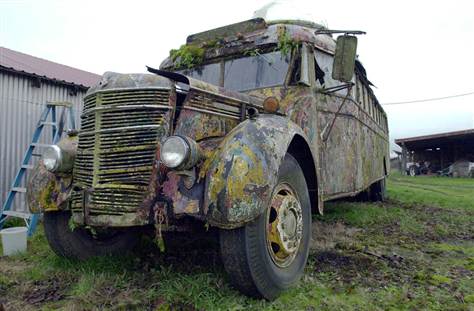I live in "Shelbyville" (as the Simpsons call it) a couple of blocks from this statue of Kesey reading to his children:

His family still runs the family dairy farm nearby in Springfield (yes, the Springfield), making "Nancy's" yogurt (Kesey named it for his bookkeeper, who was like a second mother to him). When he returned from his journey to the revive the family farm, he parked "Further" in the woods and used it to store hay for the Winter:

Local Shelbyville rumor is that she's still out there and the one in the Smithsonian is a dupe, because Kesey refused to tell anyone where she was. He didn't want it to be some kind of sacred relic, but mainly because it was a dandy place to store hay and he didn't want to go to the trouble of replacing it.
I wouldn't presume to talk about him with any familiarity, especially here, where there are people who actually knew him, the Pranksters, Bear, the Dead and everyone involved in that particular whirlwind, but as a denizen of Shelbyville and inveterate liar ... I mean storyteller, it's sometimes necessary to act as a sort of "tour guide" when it comes to Ken Kesey, just to keep the record straight. So I always tell my favorite two stories about him. The first I heard from one of his closest friends.
The story of "One Flew Over The Cuckoo's Nest" came from an experience when Kesey was a student at the University of Oregon ("Animal House" was filmed here, so you probably already know what Shelbyville looks like). Kesey saw an ad for students willing to take part in drug trials of a new alkaloid from Switzerland (again, out of deference to those who were there, that's as close as I'll come to naming it). The reason that's so vital to know is because while Kesey was under the "influence," he was basically just another college kid laying in a bunk in a dormitory and every once in a while nefarious white-coated nerds with clipboards appeared, tormenting him with bizarre tests, poking him with needles and talking about him as though he wasn't there.
Reading the story from that point of view makes a huge difference, but it also explains why Kesey refused to grant permission for the movie rights because he believed it was impossible to film, simply because everything happens inside the head of the Chief, who is an imaginary figure.
Michael Douglas managed to procure the rights (fresh off "The Streets of San Fransico," it was to be his first major film role but "the money boys" insisted on Jack Nicholson) and the rest is history. By then Kesey was tending his herd and had washed his hands of the whole deal. So he never even saw the movie or paid any attention to the Oscars showered upon it.
Except one night near the end of his life when he was watching late night TV and he tuned into a movie that seemed oddly familiar. He watched about fifteen minutes of it while experiencing a nagging suspicion that he must have seen it before, until it occurred to him. That must have been weird, huh? He turned off the TV and went to bed. I read the book again after hearing that story, and I must admit that I agree with him: it's impossible to film.
The other story I like to tell people is about the first journey of the Merry Pranksters in Further. Legend has it that the bus broke down and after working on it, Neil Cassidy's T-shirt was so greasy and vile he decided to rinse it in a nearby puddle. He noticed a swirling rainbow of colors from the oil on the surface of the puddle, and that they deposited intact to his T-shirt as he lifted it out of the water. He decided to squirt some oil paint in the puddle, and that time when he lifted the shirt, tie-dye was born.
That could be apocryphal, though. Everybody knows you shouldn't trust people from Shelbyville.